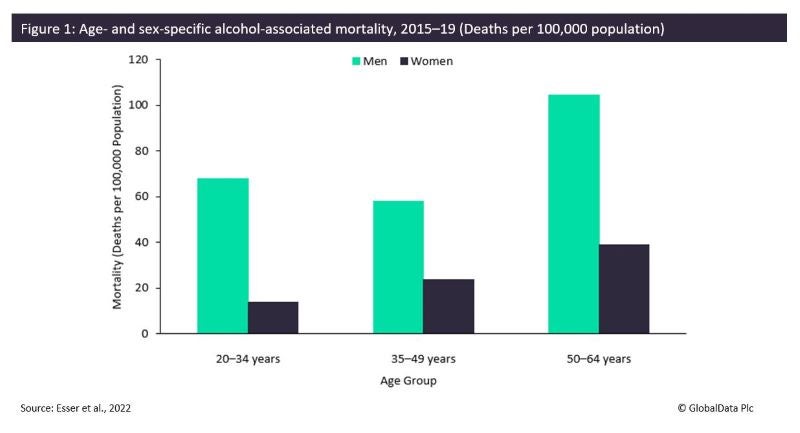Public health experts have decried a troubling increase in substance abuse across the US. A recent study published by Esser and colleagues in the Journal of the American Medical Association estimated the national epidemiological toll. Their findings, which focused on alcohol-related deaths between 2015 and 2019, suggest that as high as one in eight deaths occurring during the period could be attributable to excessive alcohol consumption. What’s more, demographic analysis of deaths reveals a high degree of sex- and age-related variation. GlobalData epidemiology forecasts, which project an increase in cases of binge drinking liver and cirrhosis, dovetail with these trends. The alarming numbers behind alcohol-associated mortality certainly present a policy challenge, but underlying causes suggest that such patterns are rooted in a more complex network of social and cultural undercurrents.
Esser and colleagues estimated the prevalence of alcohol abuse among adults ages 20 to 64 years old using the Centers for Disease Control’s (CDC) Alcohol-Related Disease Impact (ARDI) national data. Consumption was measured in conjunction with deaths from 58 causes that were directly or indirectly attributable to excessive alcohol consumption, which were collected from the National Vital Statistics System. According to the study, 8.6% of adults consumed a medium level of alcohol per day and 8.8% consumed a high amount. The prevalence of alcohol consumption was higher at all levels among men and adults between the ages of 20 and 34. Analysis of mortality showed 140,557 deaths attributable to excessive alcohol consumption, a rate of 43.2 deaths per 100,000 population. The leading cause of death among these were alcoholic liver disease, which accounted for 22,472 deaths, followed by alcohol poisoning and motor vehicle crashes at 17,671 and 12,650 deaths, respectively. The demographic distribution of the data revealed alarming patterns in alcohol-related deaths based on age and sex.
As seen in Figure 1, the mortality rate among men was 60.7 per 100,000 population, compared to women at 26.3 per 100,000 population. Age-specific rates showed a disproportionate impact of alcohol on 20- to 49-year-old adults, a cohort in which one in five deaths were attributable to excessive alcohol consumption. The authors note that alcohol consumption and deaths underwent a sharp increase during the first year of the Covid-19 pandemic. The rise in alcohol-related mortality, however, appears to follow a broader trend. GlobalData epidemiologists project that the total prevalence of binge drinking will increase from over 69,933,000 to approximately 76,069,000 cases between 2018 and 2028.
Similarly, liver cirrhosis is expected to rise from almost 219,600 in 2019 to over 236,300 total prevalent cases a decade later. Esser and colleagues have posited that reducing alcohol access through higher taxes and tighter regulations, as well as more widely available screening, could curb substance abuse. However, research suggests that deaths of despair may be rooted in more systemic causes such as economic insecurity, a loneliness epidemic, and a higher prevalence of depression and anxiety. Given the range of underlying factors, the solutions to substance abuse-related mortality and suicide will require an approach based not only in hard policy, but a broader national conversation on proactive answers to these and other social discontents.
See Also:
How well do you really know your competitors?
Access the most comprehensive Company Profiles on the market, powered by GlobalData. Save hours of research. Gain competitive edge.

Thank you!
Your download email will arrive shortly
Not ready to buy yet? Download a free sample
We are confident about the unique quality of our Company Profiles. However, we want you to make the most beneficial decision for your business, so we offer a free sample that you can download by submitting the below form
By GlobalData









Related Company Profiles
Journal Holdings, Inc.